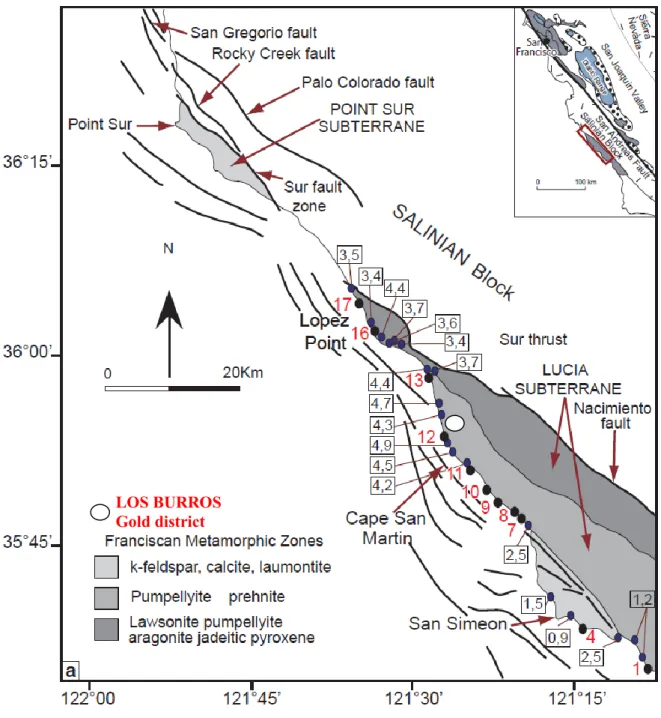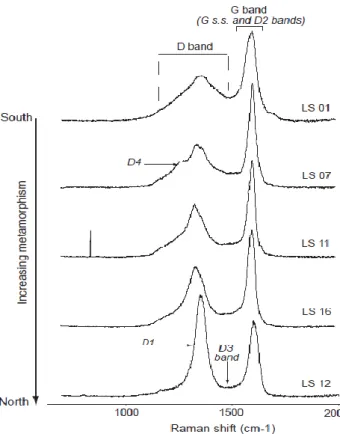HAL Id: hal-01164177
https://hal-brgm.archives-ouvertes.fr/hal-01164177
Submitted on 16 Jun 2015
HAL is a multi-disciplinary open access
archive for the deposit and dissemination of
sci-entific research documents, whether they are
pub-lished or not. The documents may come from
teaching and research institutions in France or
abroad, or from public or private research centers.
L’archive ouverte pluridisciplinaire HAL, est
destinée au dépôt et à la diffusion de documents
scientifiques de niveau recherche, publiés ou non,
émanant des établissements d’enseignement et de
recherche français ou étrangers, des laboratoires
publics ou privés.
Contribution of the RSCM Geothermometry to Detect
the Thermal Anomalies and Peak Temperatures Induced
by Fluid Circulation in Metasediments
Abdeltif Lahfid, Sylvain Delchini, Brice Lacroix
To cite this version:
Abdeltif Lahfid, Sylvain Delchini, Brice Lacroix. Contribution of the RSCM Geothermometry to
De-tect the Thermal Anomalies and Peak Temperatures Induced by Fluid Circulation in Metasediments.
13th SGA Biennial Meeting, Aug 2015, Nancy, France. 2015. �hal-01164177�
Contribution of the RSCM Geothermometry to Detect the
Thermal Anomalies and Peak Temperatures Induced by
Fluid Circulation in Metasediments.
Abdeltif Lahfid, Sylvain Delchini
BRGM, 3 avenue Claude Guillemin, 45060 Orléans, France CNRS, ISTO, UMR 7327, 45071 Orléans, France
Université d’Orléans, ISTO, UMR 7327, 45071 Orléans, France
Brice Lacroix
Department of Earth and Environmental Sciences, University of Michigan, Ann Arbor, MI 48109, USA
Abstract. The occurrence of deposits hosted by carbonaceous materials-rich metasediments is widespread. For this reason, we propose in this study to investigate the potential of the Raman Spectroscopy of Carbonaceous Material (RSCM) geothermometry to detect thermal anomalies in hydrothermal ore deposits environment. The chosen geological context is the Lucia subterrane in the Franciscan Complex (California, USA), which includes gold-bearing quartz veins (Underwood et al., 1995). Estimated Raman temperatures 1) confirmed the increase in the metamorphic grade towards the north already shown by Underwood et al. (1995), using classical methods like mineralogy and vitrinite reflectance and 2) exhibit anomalous values. These anomalies are probably due to the later hydrothermal event. This result suggests that RSCM could be used as a reliable tool to determine thermal anomalies caused by hot fluid-flow.
Keywords. Carbonaceous materials (CM), RSCM geothermometry, fluids circulation, hydrothermal over-print, peak temperatures and mineralization.
1 Introduction
Many ore-deposits are hosted in carbonaceous material-rich metasediments. Therefore the study of the maturity of carbonaceous materials provides a precise tool to estimate the peak temperatures of rocks, generally controlled by burial/exhumation of geological formations, magmatic intrusions or fluids circulations.
In the case of fluid related ore-mineralization, the presence of CM could provide accurate information on the thermal event and subsequent maximum temperature. Therefore CM could be used to investigate the paleotemperatures and to elucidate the thermal anomalies induced by fluid-flow.
Conventional techniques such as Rock-Eval pyrolysis and vitrinite reflectance provide basic data concerning the maturity degree of organic matter. Recent new geothermometric approach based on the Raman Spectroscopy of Carbonaceous Materials (RSCM) has been developed by Beyssac et al. (2002a) in the range of 330-650°C and by Lahfid et al. (2010) in the range of 200-330°C. This approach allows successfully estimating peak temperatures of diagenetic to low-grade metamorphic rocks.
The aim of this study is to demonstrate the ability of warm fluids, migrating through the sedimentary sequence
to locally disturb the thermal gradient and associated peak temperatures. For this purpose, we have chosen the Lucia subterrane in the Franciscan Complex (California, USA), which includes gold-bearing quartz veins that witness a hydrothermal overprint (Underwood et al. 1995).
2 Geological setting
The Franciscan complex represents an exhumed assemblage of an accretionary complex formed by subduction of an oceanic plate under the western margin of the North American craton. Three belts are distinguished in this area: 1) the eastern belt, 2) the central belt and 3) the coastal belt. Each belt is characterized by its accretion age, lithology and structural / metamorphic evolution and could be subdivided into terranes and subterranes (Jayko et al. 1986; Underwood et al. 1995).
In this work, we particularly focused on the Lucia subterrane (fig. 1), which is located in the San Andreas fault system. The sediments in this zone essentially comprise greywacke and shale-matrix mélange (e.g. Frey and Robinson 1999), which have undergone high-pressure, low-temperature metamorphism. The thermal history of the Lucia subterrane has been previously proposed by Underwood et al. (1995), essentially using vitrinite reflectance method (Rm) (fig. 1). Rm values increase from the south to the north; they vary between 0.9 and 2.5 % (~150-240°C) in the San Simeon region and reach 3.4% to 3.7% (~275-285°C) close to Lopez Point. The increasing metamorphism grade towards the north suggests a probable deeper structural burial within the Late Cretaceous accretionary prism (Ernst 1980). Anomalous Rm values from 4.5% to 4.9% (~305-315°C) are recorded near Cape San Martin (fig. 1). The highest temperatures estimated near Cape San Martin are likely, associated with a late hydrothermal event (Underwood et al. 1995).
The maximum temperature records, estimated using vitrinite reflectance method, have been confirmed by illite crystallinity results, which also outline similar metamorphic trend from south to north (the IC values vary from 0.80 to 0.18 ∆°2θ). All these results suggest that the Lucia subterrane underwent a regional increase of thermal gradient toward the north.
Figure 1. Simplified geologic map of central California coastline. Boxed numbers are values of mean random vitrinite reflectance for
the Lucia subterrane (after Underwood et al. 1995). Samples locations are indicated by black dots.
3 Methodology: RSCM geothermometry
Raman spectroscopy has been used in many works to study the degree of organization of carbonaceous material (e.g. Wopenka and Pasteris 1993; Yui et al. 1996; Beyssac et al. 2002a; Lahfid et al. 2010). Consequently a new geothermometer has been developed, namely the Raman Spectroscopy of Carbonaceous Material (RSCM). This tool measures the structural evolution of the carbonaceous material that is present in rocks. A first version of the RSCM was developed by Beyssac et al. (2002a) and works only to measure temperatures ranging from 330 to 650°C using the R2 parameter. This parameter corresponds to the relative area of the main defect band D1 [R2 = D1/(G+D1+D2) peak area ratio]. The applicability condition of RSCM was later expanded to lower temperatures ranging from 200 to 350°C by Lahfid et al. (2010) using RA1 parameter, defined as relative area
of D1 and D4 defect bands [RA1 = (D1+D4)/(G+D1+D2+D3+D4) peak area ratio].
Raman spectra were obtained using a Renishaw InVIA Reflex microspectrometer. Laser (514 nm) was focused on the sample by a DMLM Leica microscope equipped with an x100 objective (NA = 0.90).
The Raman spectrometer was operated using continuous scanning mode with large spectral windows from 700 to 2000 cm-1 which include all the first-order
bands and allows defining properly the baseline. Instrument control and Raman measurements were performed with the software packages Renishaw Wire. Acquisition times are generally over 10 seconds. In this study all samples were analysed using thin-sections exposed to a laser beam with power of around 0,5 mW at sample surface. To check the within-sample structural heterogeneity, at least 10 spectra were recorded for each sample.
LOS BURROS
Gold district
4 Results: Thermometric data
The Raman spectra of metasediments CM collected in the Lucia subterrane (16 samples) comprise two broad bands (fig. 2). The first band, named G band, is located at 1580 cm-1 and includes G s.s. band and D2 defect band. The
second band, named D band, is located at ~1350 cm-1 and
includes D1 and D4 bands (e.g. Lahfid et al. 2010). The Raman Parameters of these bands shows variations with decreasing of the disorder in the structure of CM. The mains variations observed are:
- the progressive narrowing of bands width. - the decreasing of the D4 parameters (relative
intensity and area)
Also, the relative increase in the signal intensity observed between the D and G bands at about 1500 cm-1
and called D3 band, is observed to be lowered when increases the thermal maturity of the CM.
Figure 2. Representative Raman spectra of carbonaceous
material of samples collected from Lucia subterrane.
Using quantitative calibration of the RSCM geothermometry (Lahfid et al., 2010), the maximum temperatures obtained reveal a progressive increase towards the north. They vary from around 220°C (between San Simeon and the south of Los Burros) to 315°C (near Lopez Point) and confirm the regional
metamorphism trend established by Underwood et al. (1995).
Anomalous high values of Raman temperature have been detected for some samples near to the Cape San Martin (temperatures reach 350°C in sample 12). This anomaly, also indicated by the vitrinite reflectance data seems to be caused by a hydrothermal overprint in the Los Burros district (Underwood et al. 1995).
5 Discussion and conclusion
Franciscan rocks along the Big Sur coastline underwent a later hydrothermal overprint (Underwood et al. 1995). The use of the vitrinite reflectance method (Underwood et al. 1995) reveals anomalous values of maximum temperature, recorded in Los Burro area (a gold district). These anomalous values, which are likely related to a thermal overprint associated to gold deposition, are confirmed by the peak temperatures obtained in this study, using the RSCM geothermometry.
This result suggests that RSCM could be used as a reliable tool to elucidate the thermal anomalies induced by a hot fluid-flow.
Acknowledgements
The authors would like to thank Mr C. Marignac for his useful comments on the manuscript.
References
Beyssac O, Goffe B, Chopin C, Rouzaud J-N (2002a) Raman spectra of carbonaceous material in metasediments: A new geothermometer. Journal of Metamorpic Geology 20:859-871 Ernst WG (1980) Mineral paragenesis in Franciscan
metagray-wackes of the Nacimiento block, a subduction complex of the southern California Coast Ranges. J Geophys Res 85:7045-7055
Frey M, Robinson D (1999) Low-Grade Metamorphism. Blackwell Science Ltd. Cambridge, 313 pp
Jayko AS, Blake MC JR, Brothers RN (1986) Blueschist metamorphism of Eastern Franciscan belt, northern California. Geol Soc Amer Mem 164:107-123
Lahfid A, Beyssac O, Deville E, Negro F, Chopin C Goffé B (2010) Evolution of the Raman spectrum of carbonaceous material in low-grade metasediments of the Glarus Alps (Switzerland). Terra Nova 22:354-360
Underwood BM, Laughland MM, Shelton KL, Sedlock RL (1995) Thermal-maturity trends within the Franciscan rocks near Big Sur, California: implications for offset along the San Gregorio-San Simeon-Hsogri fault zone. Geology 23:839-842
Wopenka B, Pasteris JD (1993) Structural characterization of kerogens to granulite-facies graphite: applicability of Raman microprobe spectroscopy. Amer Mineral 78:533-557
Yui TF, Huang E, Xu J (1996) Raman spectrum of carbonaceous material: a possible metamorphic grade indicator for low-grade metamorphic rocks. J Metam Geol 14:115-124

